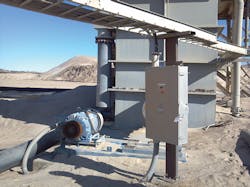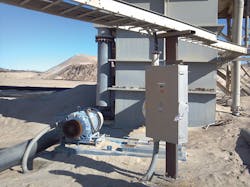Sand Processing Plant in Nebraska Doubles Production
The Midwest often endures severe winters with frigid temperatures, ice storms, and heavy snowfall. Because Preferred Sands, a sand processing facility in Genoa, Neb., depends on water to process its sand, the freezing temperatures and other inclement weather conditions often halt production at its wet sand processing facility, leaving the final dry plant short of good sand for processing before the winter ends. Thanks to new upgrades and automated controls, however, Preferred Sands is now able to process enough sand through the wet facility to keep its dry plant in Genoa running year-round.
Expanding a plant
Preferred Sands first turned to Interstates, an electrical contractor headquartered in Sioux Center, Iowa, to work on an expansion at its dry plant. At this processing facility, which is located away from the river, the company dries out the sand, sizes and grades it, and then prepares it for its customers. After successfully completing the job, Preferred Sands then hired Interstates to develop a scope of work for the wet plant portion of the processing facility. In turn, Interstates pulled in its electrical engineering and instrumentation teams to assist the automation and construction groups on this portion of the project.
The wet plant, located near the mine site along the river canal, pumps dredged sand from the mine site through its processing equipment and then up to the dry plant storage location. At the wet plant, the company begins the process of sorting the sand and disposing of the substandard sand. Later on in the process, the company sorts the sand further into specific grades and ships it out, depending on clients’ needs.
Improving productivity
On top of updating the existing equipment at the site, the contractor was responsible for installing and incorporating new mining equipment into the control system. Before Interstates began working on the system, the plant had an antiquated automated control system, but opted to run the facility in manual mode, says Jeff Miller, the director of project management for Interstates.
“We tried to create less manual work for them, improve the quality in their wet plant processes, and get more production out of the overall facility,” Miller says. “They needed to be able to process enough sand through the wet plant so the dry plant could run all winter.”
To help its client increase energy efficiency and productivity, Interstates’ electrical team installed variable-frequency drives (VFDs) on critical slurry pumps. The new large horsepower motors can now operate in a state of barely turning to full speed. By investing in these VFDs, Preferred Sands can control the flow and density of sand via its centralized control room.
The contractor also implemented more sophisticated harmonic filtering support on the distribution system to give the client cleaner power and help them to run things more efficiently, says Jason Wyenberg, electrical engineer.
Solving a plugging problem
Before working with Interstates, the company’s sand would sometimes reach too high of a density level when the workers were pumping large quantities of sand from the quarries or the transfer piping to the dry plant storage area. Consequently, the pipes would plug up, requiring 12 to 18 hr of clean out time.
Prior to implementing the new system, Preferred Sands only moved the product via manual controls at both the mine site and the wet plant. This offered limited communication, control, and visibility between the two facilities. Since installing the new control system, however, Preferred Sands has experienced a dramatic improvement in the capabilities and control of the system, practically eliminating plugging concerns.
Due to the large amount of new equipment that was brought into the plant as well as the new control system, Preferred Sands was able to double the amount of production in the mining area that brought sand into the plant.
“They now have the system set up so they can get more production capacity with very little effort,” Miller says. “They can monitor the density, affect the flow rate, and get the amount of production they need right from the control room.”
Confronting challenges
Because the Preferred Sands project was the team’s first time working in the mining industry, Interstates took special precautions to protect its field workforce. For example, its employees wore goggle-style safety glasses to protect their eyes from blowing sand as well as ventilating face masks to provide breathing protection.
“Clouds of sand would come across the site, and our field guys would still have to go out and get the work done,” says Randy Noecker, Interstates’ on-site project manager.
The crew members also had to acclimate to working around the gargantuan mining equipment. Additionally, because of the tight schedule, many other contractors were also on the project, requiring added levels of organization.
“When we got on site, there were so many things taking place, and so many little things being done,” Miller says. “Coordinating our efforts with other contractors took time, but Preferred Sands made sure that there weren’t too many tradespeople in one spot at any given time.”
To solve this problem, Interstates’ foremen participated in daily “standup meetings,” in which they met with the other trade foremen to decide when and where each should be working that day, Miller says.
Interstates also faced other challenges on the project. Because the contractor often deals more with value-added agricultural projects than mining jobs, the workers had to learn how to deal with a new product — sand slurry. In addition, engineers had to incorporate different methods of measuring the level inside the process tank, which raised and lowered very quickly. This was done using guided wave radar inside stilling wells in order to stabilize the measurements, due to the turbulence and fast changing levels, says Adam Dittbenner, service manager for Interstates’ instrumentation group. The team also learned to use nuclear technology to measure the density of sand in the process lines. This was accomplished by installing a nuclear source on one side of a pipe and a detector on the opposite side. The concentration of sand in the slurry would affect the density of the flowing product, and further affect the radiation field transmitted from the source to the detector, thus measuring the density of the slurry.
Coming together
Interstates, which has been in business for 60 years and employs 550 people across four main business groups, was able to finish the job on schedule despite the tight time frame. When the contractor arrived on site, Preferred Sands had just come out of shutdown for the winter, and it needed to get sand up to the dry plant before it ran out.
“From day one, the schedule was the biggest challenge coming at us,” says Noecker. “It took a lot of teamwork on our part and within our group to pull it off. We got the project in the first part of January, and we had to have it up and running by the time the mining season was ready to begin.”
The company wanted to pump water before the contractor could get equipment on site. By working with its vendors, however, Interstates was able to secure the hardware faster than anticipated, provide an integrated solution, and get the plant up and running on time.
The ability to prefab materials was instrumental to the success of the project, Noecker says. At its prefab facility, Interstates preassembled disconnects for the large motors, conduit racks, cable trays, and lighting assemblies. The workers then labeled each item for appropriate placement in the assembly and shipped it to the work site. Interstates’ electricians then installed the equipment at the plants.
“We approached the job with a plan and the technology to get the equipment to the site ready to install,” Noecker says. “It was plug-and-play on a huge scale.”
The Interstates team spent four months on the dry plant and three months on the wet plant. By bringing all of its business units together, Interstates was able to finish the job on schedule.
While Miller describes the end of the project as a “race to the finish,” the contractor successfully helped its client meet its goal of doubling production and improving efficiency.
Fischbach is a freelance writer based in Overland Park, Kan. She can be reached at [email protected].


